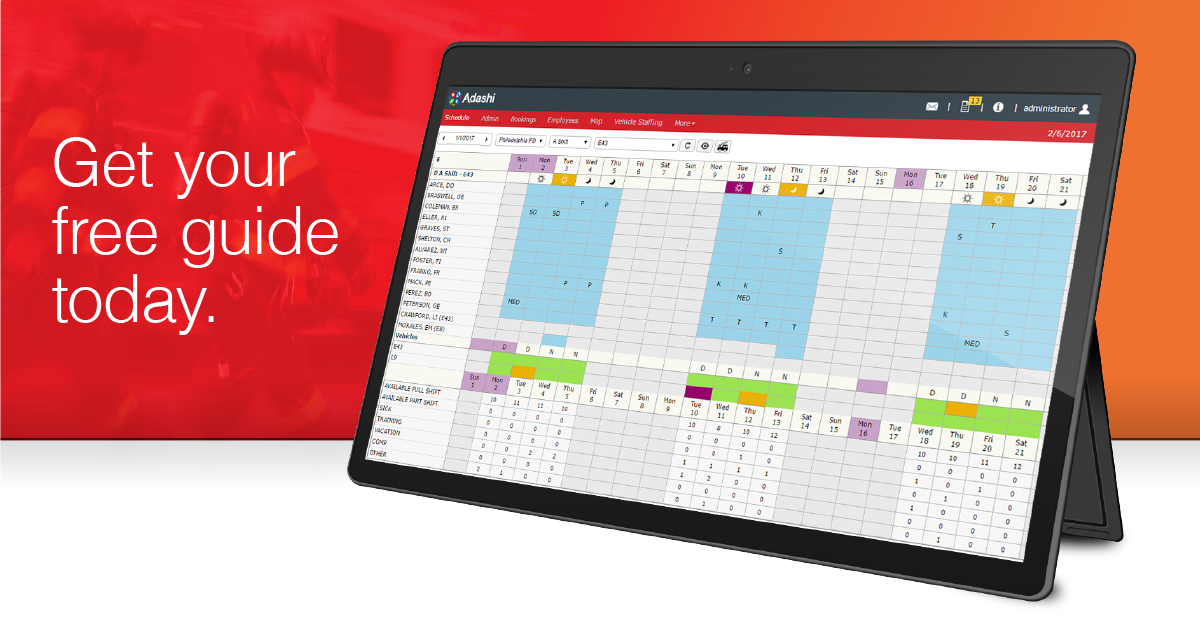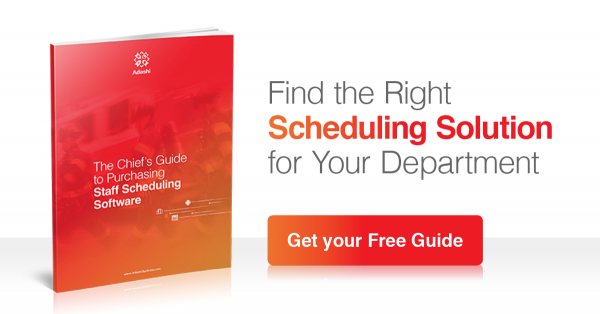When public safety agencies begin researching crew scheduling software, it’s important for them to learn about the specific capabilities of different programs. Otherwise, they might end up with a staff scheduling option that doesn’t meet their department’s full scope of needs.
Luckily, crew scheduling software providers generally offer multiple opportunities for department leaders to ask questions and see the product in action. Below are several key questions public safety leaders should always ask when they are buying staffing software for their departments.
For a full look at everything public safety leaders need to know about the scheduling software buying process from start to finish, check out our eBook: The Chief’s Guide to Purchasing Staff Scheduling Software.
9 Questions to Ask About Crew Scheduling Software
1) Will this software comply with our union rules and department policies?
Public safety agencies often have strict protocols based on various union, business, and department rules. Rules can cover overtime bidding, training requirements, and everything in between. When considering software, compliance to these standards must be a priority.
2) Is it designed for public safety needs?
If a department wants to fully implement scheduling software, they should consider whether the option they’ve chosen is well-designed for public safety needs. Some scheduling providers offer the same product across various industries, with little changes or tweaks. In contrast, there are now several options designed specifically for the needs of firefighters, law enforcement, and EMS professionals. Departments should keep in mind their unique requirements and ensure the solution they pick can meet their full range of needs.
3) Does it integrate with our existing systems?
Modern public safety departments must collect and manage a great deal of data. To keep data accurate and up-to-date, departments need staffing software that integrates with their existing systems. These might include third-party computer aided dispatch (CAD), payroll, HR, records management systems (RMS), and more.

If your department also uses incident command or emergency response software, it is important to ask whether your scheduling solution can connect with those systems as well.
4) How will it factor into our budget?
Agencies often face various budget difficulties. While a budget might seem large at first, finding the money for public safety technology can be complicated. One factor that departments should consider is whether staffing software can help them cut labor costs, freeing up more of the budget overall and leading to savings in the long run. Many scheduling options help control labor costs by reducing overstaffing and creating fair overtime allotment. When researching options, public safety leaders should consider how different types of scheduling software will affect their current budget and long-term costs.
5) Which features are specifically offered?
While crew scheduling software options might look similar on the surface, different providers often offer unique features and benefits. Before purchasing scheduling software, department leaders should make sure they fully understand what the software is capable of. Some examples of feature-related questions to ask are:
- Can rosters be viewed in advance?
- Will administrators see when certifications will expire?
- Can we set up different access levels?
Often, a product demonstration helps departments see the software in action and better understand exactly what it can do.
6) What impact will the software have on our administrative processes?
One of the biggest advantages of scheduling software is the way it can streamline your back end process and make administrative tasks more efficient. However, crew scheduling software providers offer different administrative features designed to improve efficiency. It’s important for departments to ask themselves how an option will speed up reporting, simplify call-back processes, or improve time management.
Since scheduling administrators will be the people using the software the most frequently, departments should ask them what features or factors would best improve their productivity and day-to-day activities.
7) How accessible is the software?
Some software programs are managed manually from a central computer. To make scheduling changes, administrators must go to the computer’s physical location and type in their information. In contrast, many scheduling providers now offer cloud-based solutions, which administrators can access from anywhere with an internet connection.

Cloud-based hosting also offers a few additional benefits, like disaster recovery. If the central computer breaks or gets damaged, everyone can still access the necessary data remotely via the cloud. Cloud hosting also generally allows for automatic backups and updates to keep your date secure no matter what.
Cloud hosting can also save agencies time and energy, since administrators have no central server they need to manage and maintain. When comparing software providers, accessibility and convenience are important to keep in mind.
8) Are mobile apps available?
Now that roughly 77% of Americans own a smartphone, mobile apps are on the rise. Several crew scheduling software providers offer mobile apps so that first responders can request vacation, overtime, and shift trades directly from their devices. While older scheduling options might not have apps, departments should ask providers whether mobile capability is possible for both responders and scheduling administrators.
9) Is it intuitive and easy-to-use?
If a software system is complicated, overly technical, or poorly-designed, then people won’t want to use it. To get software up-and-running in your department, agencies should explore how user-friendly their scheduling choice is. Why buy software that no one will use? If administrators and responders can’t understand how the product works even with adequate training or preparation, then it’s unlikely that they will use the product to its full capabilities.
Often, buying software can be a complicated process. But, staff scheduling software can have an enormous impact on a department’s ability to save lives, while cutting costs and making administration easy. To find the right solution for your public safety agency, departments should ask the above questions and carefully consider the responses they receive.
To learn more about the process of buying emergency responder scheduling software, download our free eBook: The Chief’s Guide to Purchasing Staff Scheduling Software.


Adashi is a leading provider of technology to public safety agencies worldwide.






